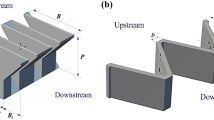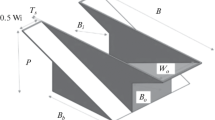Abstract
The application of a piano key (PK) weir in a channel may lead to changes in the flow characteristics, upstream siltation conditions, and bed elevation. In this study, laboratory-based Type-A PK weir models with noses below the upstream apexes were studied under different flow and siltation conditions. A total of 342 datasets were collected from the three models. Upstream siltation had no impact on the discharge efficiency of submerged PK weirs, but under the free-flow condition, there was a maximum reduction of 4% in the coefficient of discharge. Planners and designers must consider such variations in channels with a high sediment load. However, at high H/P (where H is the head over the weir crest and P is the weir height), the siltation effect starts to decrease, possibly due to the alternation in the flow condition caused by tailwater submergence. The modular submergence was found to be approximately 0.5, which is close to the values available in the literature. The proposed equations for free-flowing PK weirs performed very well with a maximum error of approximately 7% and a mean absolute percentage error (MAPE) of approximately 2.5%. Furthermore, approximately 60% of the data lie within the ± 3% error bands, and almost all data lie within the ± 6% error bands. The equations proposed for submerged PK weirs also efficiently estimated the coefficient of discharge with a maximum error ranging from 9.0 to 11.32% and an MAPE varying from 2.94 to 4.27%.










Similar content being viewed by others
Abbreviations
- a :
-
Inlet key width (m)
- b :
-
Outlet key width (m)
- B :
-
Sidewall overflowing crest length (m)
- B b :
-
Base length of the PK weir (m)
- B i :
-
Overhang length for the inlet key (m)
- B o :
-
Overhang length for the outlet key (m)
- C PK :
-
Coefficient of discharge for a PK weir with no siltation on the upstream side (–)
- C PKs :
-
Coefficient of discharge of a submerged PK weir (–)
- C PK′ :
-
Coefficient of discharge for a PK weir with upstream siltation (–)
- h :
-
Flow depth over the crest (m)
- h v :
-
Velocity head (m)
- H :
-
Total upstream head over the crest (m)
- H d :
-
Total downstream hydraulic head (m)
- L :
-
Total crest length of the weir (m)
- P :
-
Height of inlet (Pi) and outlet keys (Po) (m)
- P′:
-
Incoming flow depth below the inlet key sill (m)
- Q :
-
Discharge capacity of a PK weir (m3/s)
- Q s :
-
Discharge passing under the submerged condition (m3/s)
- T s :
-
Wall thickness (m)
- W :
-
Width of the weir (m)
- y :
-
Total upstream flow depth (m)
- S w :
-
Submergence of a PK weir (–)
- σ :
-
Surface tension (N/m)
- μ :
-
Viscosity (Pa s)
References
Leite RM, Pfister M, Schleiss AJ, Boillat JL (2012) Hydraulic design of a-type piano key weirs. J Hydraul Res 50(4):400–408
Lempérière F, Ouamane A (2003) The piano keys weir: a new cost-effective solution for spillways. Int J Hydropower Dams 10(5):144–149
Leite RM, Bieri M, Boillat JL, Schleiss AJ, Singhal G, Sharma N (2012) Discharge capacity of piano key weirs. J Hydraul Eng 138(2):199–203
Singhal GD, Sharma N (2011) Rehabilitation of Sawara Kuddu Hydroelectric Project—model studies of piano key weir in India. In: Proceedings of the international conference on labyrinth and piano key weirs—PKW 2011, Liege, Belgium. CRC Press, London, pp 241–250
Noseda M, Stojnic I, Pfister M, Schleiss AJ (2019) Upstream erosion and sediment passage at piano key weirs. J Hydraul Eng 145(8):04019029
Laugier F (2007) Design and construction of the first piano key weir spillway at Goulours dam. Int J Hydropower Dams 14(5):94–101
Erpicum S, Archambeau P, Dewals B, Pirotton M (2017) Hydraulics of piano key weirs: a review. In: Proceedings of the 3rd international workshop on labyrinth and piano key weirs (PKW 2017), Qui Nhon, Vietnam. CRC Press, London, pp 27–36
Crookston BM, Erpicum S, Tullis BP, Laugier F (2019) Hydraulics of labyrinth and piano key weirs: 100 years of prototype structures, advancements, and future research needs. J Hydraul Eng 145(12):02519004
Lempérière F, Vigny JP, Ouamane A (2011) General comments on labyrinths and piano keyweirs: the past and present. In: Proceedings of the international conference on labyrinth and piano key weirs—PKW 2011, Liege, Belgium. CRC Press, London, pp 17–24
Kabiri-Samani A, Javaheri A (2012) Discharge coefficients for free and submerged flow over Piano Key weirs. J Hydraul Res 50(1):114–120
Oertel M (2018) Piano key weir research: state-of-the-art and future challenges. In: 7th IAHR international symposium on hydraulic structures, Aachen, Germany. Utah State University, pp 474–481
Anderson RM, Tullis BP (2013) Piano key weir hydraulics and labyrinth weir comparison. J Irrig Drain Eng 139(3):246–253
Anderson RM, Tullis BP (2012) Comparison of piano key and rectangular labyrinth weir hydraulics. J Hydraul Eng 138(4):358–361
Belaabed F, Ouamane A (2013) Submerged flow regimes of piano key weir. In: Proceedings of the second international workshop on labyrinth and piano key weirs—PKW 2013, Paris, France. CRC Press, London, pp 85–92
Cicero GM, Delisle JR (2013) Discharge characteristics of piano key weirs under submerged flow. In: Proceedings of the second international workshop on labyrinth and piano key weirs—PKW 2013, Paris, France. CRC Press, London, pp 101–109
Crookston BM, Anderson RM, Tullis BP (2018) Free-flow discharge estimation method for piano key weir geometries. J Hydro-environ Res 19:160–167
Karimi CM, Nazari S, Shooshtari MM (2019) Investigating the effect of a parapet wall on the hydraulic performance of an arced piano key weir. J Hydraul Res 58(2):274–282
Kumar B, Kadia S, Ahmad Z (2019) Evaluation of discharge equations of the piano key weirs. Flow Meas Instrum 68:101577
Laugier F, Pralong J, Blancher B (2011) Influence of structural thickness of sidewalls on PKW spillway discharge capacity. In: Proceedings of the international conference on labyrinth and piano key weirs—PKW 2011, Liege, Belgium. CRC Press, London, pp 159–165
Lempérière F (2009) New labyrinth weirs triple spillways discharge, dams, piano keys weirs, tidal energy and energy storage. http://www.hydrocoop.org. Accessed 13 June 2019
Li G, Li S, Hu Y (2019) The effect of the inlet/outlet width ratio on the discharge of piano key weirs. J Hydraul Res 58(4):594–604
Machiels O, Erpicum S, Archambeau P, Dewals B, Pirotton M (2011) Piano key weir preliminary design method: application to a new dam project. In: Proceedings of the international conference on labyrinth and piano key weirs—PKW 2011, Liege, Belgium. CRC Press, London, pp 199–206
Machiels O, Erpicum S, Archambeau P, Dewals B, Pirotton M (2013) Parapet wall effect on piano key weir efficiency. J Irrig Drain Eng 139(6):506–511
Machiels O, Pirotton M, Pierre A, Dewals B, Erpicum S (2014) Experimental parametric study and design of piano key weirs experimental parametric study and design of piano key weirs. J Hydraul Res 52(3):326–335
Pfister M, Schleiss AJ (2013) Effect of driftwood on hydraulic head of piano key weirs. In: Proceedings of the second international workshop on labyrinth and piano key weirs—PKW 2013, Paris, France. CRC Press, London, pp 255–264
Dabling MR, Tullis BP (2012) Piano key weir submergence in channel applications. J Hydraul Eng 138(7):661–666
Tullis BP, Young JC, Chandler MA (2007) Head-discharge relationships for submerged labyrinth weirs. J Hydraul Eng 133(3):248–254
Kabiri-Samani A, Ansari A, Borghei SM (2010) Hydraulic behaviour of flow over an oblique weir. J Hydraul Res 48(5):669–673
Villemonte JR (1947) Submerged weir discharge studies. Eng News Rec 139(26):54–57
Erpicum S, Tullis BP, Lodomez M, Archambeau P, Dewals BJ, Pirotton M (2016) Scale effects in physical piano key weirs models. J Hydraul Res 54(6):692–698
Tullis BP, Crookston BM, Young N (2020) Scale effects in free-flow nonlinear weir head-discharge relationships. J Hydraul Eng 146(2):04019056
Novak P, Cabelka J (1981) Models in hydraulic engineering: physical principles and design applications. Pitman Publishing Ltd, Boston
Henderson FM (1966) Open channel flow. Macmillan, New York
Jüstrich S, Pfister M, Schleiss AJ (2016) Mobile riverbed scour downstream of a piano key weir. J Hydraul Eng 142(11):04016043
Acknowledgements
The first author would like to express his gratitude to the Ministry of Human Resource Development, Govt. of India for granting research scholarship.
Author information
Authors and Affiliations
Corresponding author
Ethics declarations
Conflict of interest
The authors hereby declare that they do not have any conflicts of interest.
Rights and permissions
About this article
Cite this article
Kumar, B., Kadia, S. & Ahmad, Z. Discharge Characteristics of Piano Key Weirs with and Without Upstream Siltation. Int J Civ Eng 19, 1043–1054 (2021). https://doi.org/10.1007/s40999-021-00607-x
Received:
Revised:
Accepted:
Published:
Issue Date:
DOI: https://doi.org/10.1007/s40999-021-00607-x




